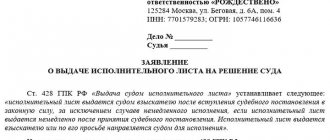A writ of execution for alimony should be obtained from the court where the decision to collect it was made. This can be done immediately after the court has announced the operative part of the decision, since this executive document is subject to immediate execution. There is no need to wait for the court decision to enter into legal force.
Court decision to collect alimonyHow to get a writ of execution for alimony
To obtain a writ of execution, you must write a corresponding application and submit it to the court office. You can immediately check with the assistant judge when the document will be produced, whether it is possible to receive it on the day the decision is announced, or whether you must arrive on a certain date and time.
Application for issuance of a writ of execution
Writ of execution for alimonyAccording to Article 428 of the Code of Civil Procedure of the Russian Federation, a writ of execution for the collection of alimony for minor children is issued immediately after the adoption of a court decision. The form of the writ of execution has been approved by the Government of the Russian Federation.
If alimony was collected without calling the parties to court, in the order of writ proceedings, then a court order can be obtained in court within 5 days after filing an application for the issuance of a court order.
A court order is also an executive document and is subject to immediate execution.
Next, the writ of execution can be submitted for execution to the Federal Bailiff Service or at the debtor’s place of work. We recommend using the second option in cases where the debtor has been working for a large company with its own legal department for a long time. In other cases, it is better to submit the document to the FSSP of the Russian Federation.
The writ of execution document can be presented to the bailiff service during the entire period for which alimony is assigned and for 3 years after the end of this period.
What to do if the bailiff has lost the sheet
In case of loss of IL in accordance with paragraph 1 of Art. 430 of the Code of Civil Procedure of the Russian Federation, the claimant must apply to the court that issued the original with an application to issue a duplicate. This can be done at any time.
If the document was lost by the bailiff, he may be fined in accordance with Art. 431 Code of Civil Procedure of the Russian Federation, taking into account the provisions of Ch. 8 Code of Civil Procedure of the Russian Federation.
The parties are notified of the date and place of consideration of the application, but failure to appear is not grounds for canceling the court hearing, postponing it, or refusing to consider the application.
How to find out the amount of alimony based on a writ of execution
The amount of alimony is indicated in the IL. If it has already been handed over to the bailiffs, the information can be found in the court decision.
The court sets the amount of the penalty as a percentage of income and as a fixed sum of money, depending on the circumstances of the case under consideration.
If the payer has official income, payments are collected in accordance with Art. 81 RF IC:
- 25% – for one child.
- 33% – for two children.
- 50% – for three children or more.
If there are several dependents, the amount is divided equally between all. For example, if previously the payer transferred 33% (16.5% for each) to two children from his first marriage, and then alimony was collected for the third child, the total amount of payments will be 50% of income or 16.66% for each.
Child support payments are calculated according to the following scheme:
N – the amount of the penalty established by the court depending on the number of children.
When alimony is assigned in a fixed amount, the payments will be the same. When the cost of living increases, payments are also indexed by the employer or bailiff. If the monthly salary decreases, alimony remains the same.
If the alimony in shares is not enough to support the child, his parent has the right to recover payments in a fixed amount.
How to find out where the writ of execution is located
If proceedings are initiated, the IL will be kept by the bailiff or employer.
You can find out the location of the sheet by contacting the payer’s employer, if the claimant independently sent the documents to the manager of the alimony obligee.
If enforcement proceedings were not initiated and the claimant did not independently send a document on withholding alimony in the name of the employer, then it is almost impossible to find the sheet. In this case, it is more rational to apply to the court for a duplicate.
Does a writ of execution affect the hiring decision?
According to the law, infringement of a citizen’s rights during employment due to the presence of enforcement proceedings is not allowed; such behavior is discrimination.
At the same time, most employers refuse to employ those liable for alimony, since the organization is assigned additional responsibilities for withholding, recalculating and indexing alimony payments, which is not always rational. At the same time, for incorrect accrual or untimely sending of funds, responsibility falls on the accounting department of the enterprise.
Initiation of enforcement proceedings
The first thing you need to do to begin the procedure for collecting alimony is to submit a writ of execution for execution. To do this, you will need to prepare an application to the Federal Bailiff Service and attach to it a copy of the court decision to collect alimony and the original writ of execution. It is also advisable to attach bank details for transferring alimony (or simply indicate them in the application) and documents with information about the debtor, for example, a copy of his passport with registration, documents about his property, work activity and others that may be useful for the bailiff to search the debtor and his property.
Application for acceptance of a writ of execution for execution
The application should be submitted to the territorial department of bailiffs at the place of residence of the alimony payer.
According to the law, the writ of execution for alimony, after being received by the bailiff department, is immediately transferred to the bailiff. Within 24 hours from the date of receipt of the application, a decision must be made to initiate enforcement proceedings.
If there is a debt under the writ of execution, bailiffs must begin carrying out enforcement actions no later than the next working day after the initiation of enforcement proceedings.
Resolution on initiation of enforcement proceedingsThe resolution to initiate enforcement proceedings is sent to the debtor no later than the day following the day of its issuance. Within a day of receiving it, he must transfer alimony.
This can be done in several ways, all of which will be listed in the resolution. Typically, debtors use a transfer to the bank details of the bailiff department (listed at the end of the resolution), online payment on the website of the Federal Bailiff Service of the Russian Federation or on the website of the State Services.
If the debtor does not fulfill the requirements within the prescribed period, he will be charged an additional enforcement fee in the amount of 7% of the debt amount and not less than 1,000 rubles.
Debtors for alimony should keep in mind that after receiving the decree, they must contact the bailiff department at the address indicated in the decree. If alimony was paid directly to the claimant, it is required to provide the bailiff with copies of payment documents.
It is also required to provide information about property, the right to drive vehicles, place of residence, work, study, salary, pension, and bank accounts. If necessary, the bailiff may request this information from the competent authorities.
Cover of enforcement proceedings
The bailiff has the full right to enter the debtor’s residential premises without his consent (with the written permission of the senior bailiff). (Federal Law dated October 2, 2007 N 229-FZ (as amended on July 31, 2020) “On Enforcement Proceedings.” Article 64. )
As a rule, such visits to debtors are carried out by bailiffs several times a week. In this case, an act of execution of enforcement actions is drawn up and photographs can be taken. All materials are placed in enforcement proceedings.
How long does it last?
A writ of execution in cases of alimony collection can be presented throughout the entire period of the obligation to pay alimony. The document can also be presented for collection within three years after the period of obligation for periodic alimony transfers has expired. For debt collection.
Important! Upon the child's 18th birthday, the accrual of child support ceases. However, the accumulated alimony debt itself will not go away. Amounts may be withheld from the debtor's pensions and other periodic income, as well as collected from the estate. Additionally, a penalty may be assessed for untimely payment amounts.
Familiarization with the materials of enforcement proceedings
You can also track the presence of alimony arrears on the website of the FSSP of the Russian Federation.
Information about alimony debt on the website of the FSSP of the Russian Federation
The claimant has every right to be interested in the materials of the enforcement proceedings, come to an appointment with the bailiff and find out what requests were sent, what procedures were carried out and submit their own statements with demands to the office.
Reception hours for Moscow bailiffs: Tuesday from 9:00 to 13:00; Thursday from 13:00 to 18:00.
Application for provision of materials of enforcement proceedings for review
You can also request from the bailiff a summary of the enforcement proceedings, which will indicate: when and what requests were sent, what information about the debtor was requested.
Summary of enforcement proceedings
How is child support withheld?
According to Art. 98, 99 Federal Law No. 229 of October 2, 2007, when withholding and transferring alimony according to a writ of execution, the following actions are performed:
- They calculate alimony after deducting personal income tax from the monthly salary of the alimony payer;
- Specific alimony payments are calculated once a month;
- transfer a certain amount to the recipient's account. This operation is carried out through the mail (postal order is sent) or through a specific bank.
Important! According to Art. 109 of the RF IC, alimony is accrued to the recipient’s account within 3 days from the moment the salary is transferred to the alimony payer.
Federal Law of October 2, 2007 No. 229-FZ “On Enforcement Proceedings”
Read also: How to put a child support debtor on the wanted list
Article 109 of the Family Code of the Russian Federation “Obligation of the organization’s administration to withhold alimony”
How much is alimony calculated?
According to Art. The RF IC, depending on the number of minor children, alimony is withheld in the following amounts:
- for 1 child - 25% of the debtor’s salary;
- for two children - 1/3 of monthly income;
- if there are 3 or more children - 50% of the salary.
Attention! Alimony is withheld from all types of official payments.
According to Art. 101 Federal Law No. 229 of October 2, 2007, in this situation the following are considered non-taxable income of the alimony payer - survivor pensions, funds from maternity capital, compensation for various vouchers, etc.
Article 81 of the Family Code of the Russian Federation “Amount of alimony collected from minor children in court”
Methods for transferring alimony payments
Alimony is listed as follows:
- when transferring money in person - by receipt;
- when making a transfer via mail, bank cash desk or terminals;
- when withholding money from the salary of the alimony payer - according to a payment order from the accounting department of the employing enterprise.
The receipt indicates basic information about the recipient and the alimony payer (including data from passports), the date of receipt of funds and their amount. This document also states the purpose of the “alimony” payment and provides information about the new writ of execution or agreement.
Payment order for alimony calculation
The payment order for the collection of alimony, which is drawn up in the accounting department of the employer of the alimony payer, indicates the following information:
- Document Number;
- Date of registration, transfer to the bank and debiting of funds from the alimony payer’s account;
- Information from the passport and other details of both parents;
- Amount to be paid (in words);
- Assignment of monthly payment (“alimony”);
- Sequence and type of payment.
Sample of filling out a payment order
Attention! Alimony is considered first priority payments. As a result, they are calculated before the deduction of personal income tax, payment of wages and other money transfers.
Purpose of payment
The purpose of payment is considered an important payment detail. This paragraph of the payment order for alimony indicates the following information:
- Purpose of money transfer (“alimony”);
- Grounds for transfer of alimony money (number of the writ of execution or agreement);
- The period for which alimony is transferred (specific month and year).
The payment order also indicates the fact that alimony payments are calculated after personal income tax is withheld from the alimony payer’s salary.
From what day is alimony calculated?
The start date for the transfer of alimony to the recipient’s card or other current account is considered to be the day the claim is filed in court.
The 3-year limit applies only to the initial claim for alimony payments. Attention! If the magistrate’s court has already made a specific decision on the collection of alimony, then if alimony payments are evaded, the entire amount of the debt is recovered from the alimony payer for the entire period of non-payment - for at least 3 years, at least for 11 years.
Monthly alimony payments are collected even after the teenager turns 18 years old. In this situation, they go to court within such a period - until the adult child reaches 21 years of age.
Terms and rules of accrual
The calculation of alimony payments begins immediately after the announcement of the court order.
In this situation, the alimony payer transfers to the recipient a certain amount for 1 month within 5 days. Further, alimony payments are deducted monthly from the debtor’s monthly salary. If there are various alimony debts, the amount of payments is increased by the amount of the penalty. According to Part 2 of Art. 115 of the RF IC, such a fine is equal to 0.1% of the total debt for each day of delay.
Alimony payments are stopped for the following legal reasons:
- when the teenager is 18 years old;
- when a child is abandoned and adopted by a new family;
- upon the death of a minor or alimony payer, etc.
On a note! Becoming disabled, taking a well-deserved rest (retirement) and entering into a second marriage are not considered legal grounds for canceling alimony payments.
The amount and procedure for calculating such money change, for example, if the alimony payer becomes ill with a serious illness (oncology, AIDS, etc.).
Article 115 of the Family Code of the Russian Federation “Responsibility for late payment of alimony”
Document validity period
The validity period of a writ of execution is 3 years from the date a certain court order enters into legal force. The same time is counted from the moment the child comes of age.
Read also: How to get a divorce if your husband is in prison
In the absence of a writ of execution, the FSSP does not initiate new enforcement proceedings. In this situation, the claimant goes to court and files a petition to restore such a document.
Calculation of alimony debt
If the debtor neglects to pay alimony every month, demand that the debt be calculated and that you receive the appropriate decree.
Application for issuance of a resolution on debt settlement
It is not necessary to prepare and print out all applications in advance; depending on the situation, they can be written immediately at the reception by the bailiff by hand and submitted for stamping.
Resolution on calculation of alimony debt
With this document, you can go to court and demand to collect from the debtor, in addition to the assigned alimony, a penalty in the amount of 0.01% for each day of delay in payment.
Where can I get the document?
To obtain a writ of execution, you need to contact the court that ordered the citizen to pay alimony. The writ of execution can be served on the claimant or sent to the bailiff or, at the request of the claimant, at the payer’s place of employment.
In Moscow, the document can also be sent electronically. Then the writ of execution must be signed with the electronic digital signature of the judge.
It is advisable for the claimant to check the contents of the enforcement court in advance. It is necessary to check the information specified in it with the information indicated in the court decision.
Note: You should carefully check the full name, date, and place of birth of the participants in the enforcement proceedings and the child. It is important to check the court's requirement and the operative part of the decision. If errors or typos are discovered, you must inform the court employee about this and ask them to remove the deficiencies.
Be careful: after the sheet has been issued and enforcement proceedings have been initiated, it will not be possible to simply go to court and replace the erroneously issued document - the issue of correcting errors will be resolved at a court hearing.
Bringing the debtor to administrative liability
If more than two months have passed since the initiation of enforcement proceedings, and the debtor has not begun to pay anything, you can demand that he be brought to administrative responsibility.
To do this, you need to write an application to bring the debtor to administrative liability according to the template given above. Article 5.35.1 of the Code of Administrative Offenses of the Russian Federation provides for failure by a parent to pay child support to his children without good reason for 2 or more months from the date of initiation of enforcement proceedings in the form of:
- compulsory work for up to 150 hours;
- administrative arrest for a period of 10 to 15 days;
- imposition of an administrative fine in the amount of 20,000 rubles (for persons to whom compulsory labor and arrest cannot be applied).
The next step after administrative liability may be criminal liability under Article 157 of the Criminal Code of the Russian Federation for malicious evasion of alimony payments. In this case, the debtor is threatened with:
- correctional or forced labor for up to 1 year;
- arrest for up to 3 months;
- imprisonment for up to 1 year.
Procedure for collecting alimony payments
After receiving the writ of execution, it is independently transferred to the specific employer of the alimony payer.
If this is not available, this document is sent to the FSSP office at the defendant’s place of residence or to a local branch. An application for the collection of alimony is also submitted to this body.
Attention! The writ of execution is sent to the plaintiff—the child’s parent and the debtor—who is given 5 days to fulfill his child support obligations. In the absence of a positive result, compulsory collection measures are applied to the alimony payer.
Search for the debtor and his property
In the absence of information about the whereabouts of the debtor and his property, the applicant may apply to the bailiff to search for the debtor and his property.
The bailiff, within 3 days from the receipt of such a statement, must issue a corresponding resolution, indicating the specific enforcement actions that must be taken or enforcement measures that must be applied during the search.
The search order, no later than the next working day, is sent for the search to the bailiff who is competent to do this, and is subject to immediate execution.
In this case, the claimant has the right to receive a certificate from the bailiff stating that the debtor is wanted and the child is not receiving alimony. This certificate is presented to the social protection authority to assign an additional social benefit to the child.
Resolution to search for the debtor's accounts
When do you need to pay child support through bailiffs yourself?
| No. | Difficulties paying child support |
| 1 | The payer’s income is unofficial, he does not have a job, but he is not registered with the Employment Center |
| 2 | the payer is an individual entrepreneur and the exact amount of his profit for the month cannot be verified by the bailiffs by the date of calculation of alimony |
| 3 | the parent receives income irregularly, in kind or seasonally |
In this case, you need to know how to pay alimony through bailiffs and whether it can be done.
Imposing restrictions on leaving the Russian Federation
Also, the claimant has the right to apply for the imposition on the debtor of a restriction on leaving Russia if he has arrears of alimony in excess of 10,000 rubles. (Federal Law dated October 2, 2007 N 229-FZ (as amended on July 31, 2020) “On the executive production". Article 67.)
Application for establishing a temporary restriction on leaving the Russian Federation for the debtor
The travel restriction is imposed for 6 months; if after the expiration of this period the debt is still not repaid, the bailiff will issue a new ruling. When the debt is repaid, the restriction is lifted, but debtors should keep in mind that this does not happen every day, but on average within a week.
Resolution on temporary restriction of the debtor's departure from the Russian Federation
Payment of alimony
Payment is made for the entire period during which the obligated person must fulfill his financial obligations to children and other recipients. Alimony is withheld at the debtor's place of work in the amount of the awarded amount or debited from bank accounts, cards, or collected from other periodic income, from which payments can be withheld.
For example, citizen Agafonov must pay his child monthly alimony in the amount of 6,500 rubles. This amount, regardless of the payer’s wishes, if he has a stable job, in addition to personal income tax, will be withheld by the company’s accountant. At the same time, Agafonov has the right to ask the claimant to withdraw the sheet, but this does not deprive him of the obligation to pay alimony in the amount specified in the decision.
Imposing restrictions on driving vehicles
Also, if there is a debt of more than 10,000 rubles, you can restrict the defaulter from driving cars and other vehicles. As practice shows, such a measure of indirect coercion is very effective (Federal Law dated October 2, 2007 N 229-FZ (as amended on July 31, 2020) “On Enforcement Proceedings.” Article 67.1.). Switching from a car to public transport is a good incentive for debtors to pay maintenance to their children.
However, it is worth keeping in mind that such restrictions cannot be applied:
- if, as a result of the imposition of a restriction, the debtor will be deprived of his main source of livelihood;
- if a car is the only means for him and his family members to ensure their livelihoods, taking into account the limited transport accessibility of their place of permanent residence;
- if the debtor uses a vehicle due to a disability, or is dependent on a disabled person of group I or II or a disabled child.
Resolution on a temporary restriction on the debtor’s use of a special right
Application at the place of employment
The simplest option for collecting alimony is to contact the employer of the alimony payer.
In this situation, after receiving a writ of execution, the company where the debtor works issues an official order to withhold a specific alimony amount from the employee’s monthly salary. When executing the order of the director of the company, a separate payment order is issued in the accounting department of the enterprise and a targeted monthly payment is drawn up for the child. The employer is prohibited from carrying out any manipulations with the amount of alimony contributions (for example, reducing or stopping them).
Storage and recording of judicial documentation in the payer’s organization
Writs of execution are stored in metal company cabinets, various safes or in special premises of the enterprise, where their safety is ensured. Such treatment of such documentation is established in clause 6.2 of the Regulations of the USSR Ministry of Finance No. 105 of July 29, 1983.
Regulations of the USSR Ministry of Finance No. 105 of July 29, 1983 “Regulations on documents and document flow in accounting”
Terms and rules of accrual
It was previously noted that after the court issues a positive verdict, the plaintiff will be issued a writ of execution. It must be given to the bailiffs or sent to work for the defendant.
The calculation of alimony begins immediately after the decision is announced; the payer must immediately pay the amount accrued for one month. Then he pays monthly, guided by the information in the writ of execution. If there is a debt, the amount of payments will increase due to penalties and interest.
What is the accountant’s responsibility for withholding and transferring alimony payments?
If alimony is untimely withheld from an employee’s salary according to a specific writ of execution, the company’s accountant will be brought to criminal or administrative liability. According to paragraph 3 of Art. 17.14 of the Code of Administrative Offenses of the Russian Federation, if such a situation arises, they are fined the following amounts:
- citizens of the Russian Federation - by 2,000-2,500 rubles;
- officials - 15,000-20,000 rubles;
- legal entities - by 50,000-100,000 rubles.
Attention! In case of malicious violation of official duties regarding the withholding and transfer of alimony, the official is sent to prison for a maximum of 1 year (Article 315 of the Criminal Code of the Russian Federation).
Article 17.14 of the Code of the Russian Federation on Administrative Offenses “Violation of legislation on enforcement proceedings”
Article 315 of the Criminal Code of the Russian Federation “Failure to comply with a court sentence, court decision or other judicial act”
Applications for proceedings for alimony payments
To begin enforcement proceedings, you will need to write an application to the bailiff service. If the claimant decides to terminate the proceedings, he writes a statement to terminate the proceedings, and if he changes his mind, to resume the enforcement process.
Let's consider the nuances of drawing up these documents.
About excitement
This document is drawn up in the name of the head of the district bailiff department. The document contains the applicant's contact information, including home address.
The application must indicate:
- personal and contact information of the creditor and debtor;
- name, number and date of issue of the IL;
- amount of recovery;
- information about the work, place of residence of the debtor;
- Bank account details for transferring money.
The applicant requests to accept forcible execution of the penalty. To transfer money, indicate the current bank account, as well as the recipient's details. A writ of execution is attached to the application to initiate proceedings.
We talk about how to correctly draw up such a statement in the SPP here.
About termination
Enforcement proceedings may be terminated at the initiative of the claimant. This usually happens if the parties have agreed among themselves.
You need to submit an application to the court to terminate the proceedings and indicate that you are refusing alimony, as well as indicate the reason (reconciliation with your husband, etc.). Next, the court will issue an act of termination of execution of the sheet issued by it. After this, all that remains is to leave a statement to the bailiff to terminate the enforcement proceedings. There is no state duty for filing such an application.
The text must indicate the name of the performer and attach documents confirming the existence of grounds for termination of production. The court considers the application within ten days. The result should be a court ruling that immediately takes effect.
For renewal
The document is drawn up in simple written form and submitted to the court or FSPP. It is necessary to indicate the sheet and case number, as well as state the reason why the collection of funds from the debtor was once suspended.
Further in the statement it is worth asking to consider the issue of resuming production. A copy of the sheet and the resolution to initiate and then suspend the proceedings are attached to the document. The application is submitted to the court that made the decision to suspend alimony.










